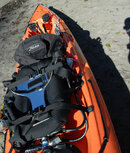Spearo
Contributor
I own three Ocean yaks (all sit on top) and like them all. This brand can sure "take it" not like other brands I use to have in the past.
Freediving in the open ocean from the smallest of them is great but I rather use the boat if I want to scubadiving or spearfishing in the open water. Lets face it..I love the rigs and the time I spend on them but it has it's limitations too.
Forget it if there is wind, forget it is there is a current, forget it if you're loaded with gear in open water and want to bring them all back home at the end of the day.
There are also problems with mid to lg. size yaks when coming back and landing/beaching in the surf from the open ocean.
Expensive scuba gear can get lost with a blink of an eye using them to dive from, I don't know how expensive your is but mine is big bucks but...there is always that nice little lake or that flat little cove out of the way that things may work for you.
Good luck guys, just bringing out the good , the bad and the ugly. LOL
Freediving in the open ocean from the smallest of them is great but I rather use the boat if I want to scubadiving or spearfishing in the open water. Lets face it..I love the rigs and the time I spend on them but it has it's limitations too.
Forget it if there is wind, forget it is there is a current, forget it if you're loaded with gear in open water and want to bring them all back home at the end of the day.
There are also problems with mid to lg. size yaks when coming back and landing/beaching in the surf from the open ocean.
Expensive scuba gear can get lost with a blink of an eye using them to dive from, I don't know how expensive your is but mine is big bucks but...there is always that nice little lake or that flat little cove out of the way that things may work for you.
Good luck guys, just bringing out the good , the bad and the ugly. LOL




